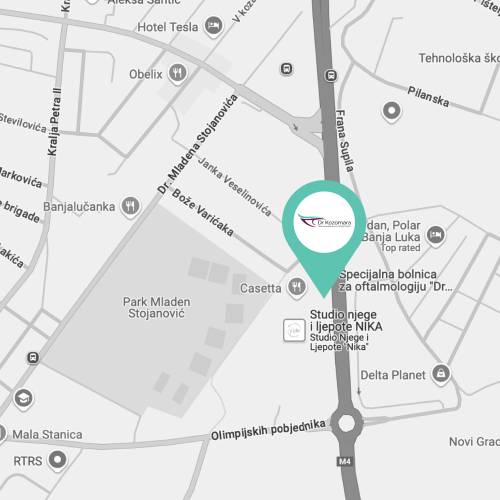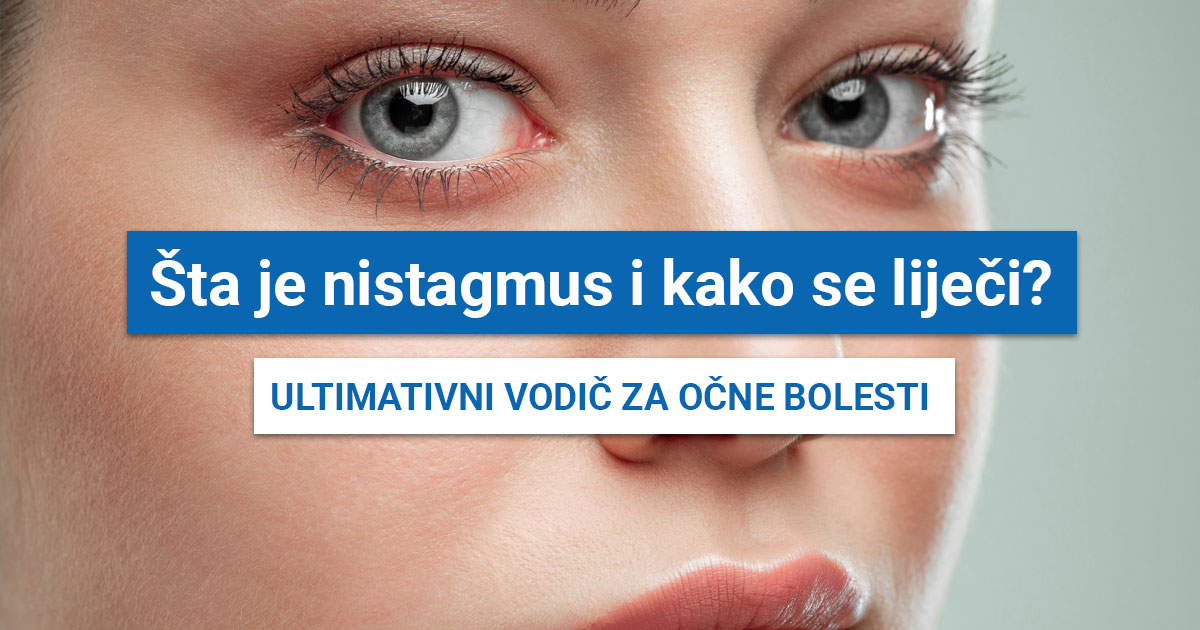
NYSTAGMUS (SYMPTOMS, CAUSES, TREATMENT, EXERCISES AND TYPES)
In the text you are reading, you will find a detailed guide on the subject of the eye disease called nystagmus. We wrote about the causes and symptoms of this health problem, what types of nystagmus exist, how nystagmus is diagnosed, how nystagmus is treated, and what are the best exercises for nystagmus. Important tips for living with nystagmus await you at the end of the text..
What is nystagmus?
Nystagmus is an eye condition in which you cannot control the movement of your eyes. Some describe it as a condition in which the eyes have their own will as they move up – down (vertical nystagmus), left-right (horizontal nystagmus), or in a circle (rotational nystagmus). Nystagmus is also called “dancing eyes”.
Eye movements in nystagmus can vary from slow to fast and usually occur in both eyes at once. People who have nystagmus often turn their heads to one side or tilt them to see more clearly, and this can help to steady their eye movements.
Causes of nystagmus
The brain controls eye movements. The eyes automatically adapt to head movements to make the vision as sharp as possible. This is precisely what stabilizes the image you are looking at and you see it clearly. In people who have nystagmus, the parts of the brain that control eye movements do not work as they should. In some people, the cause of nystagmus is unknown, but in some cases, it may be related to other problems such as:
- Hereditary factor
- Other eye diseases such as strabismus or cataracts
- Multipla skleroza, moždani udar, Menijerova bolest
- Head injury
- Middle ear problems
- Use of certain medications such as lithium or other medications to prevent seizures
- Drug and alcohol use
What types of nystagmus are there?
There are two types of nystagmus: congenital and acquired.
- Congenital nystagmus
This type of nystagmus occurs in newborns, most often between six weeks and three months of age.Children who have it usually tend to have it in both eyes, and it is manifested by moving the eyes from left to right. Doctors generally do not know what causes this condition in children, and in most cases it is hereditary.
It is a misconception that children who have nystagmus shake the objects they look at, in fact, their vision is blurred.
- Acquired nystagmus
It is a type of nystagmus that occurs later in life and can be the result of a number of conditions such as serious health problems or the use of drugs and alcohol.
Symptoms of nystagmus
The first and most obvious symptom that indicates nystagmus is that your eyes move without your control. Movements can be fast, they can be slow, they can occur in only one eye, but more often they occur in both. You may also notice how you move your head to one side or hold it in a completely incorrect position so that they can see better. You do this because it helps you focus when you can’t rest your eyes because things look clearer when you tilt your head.
As we have already mentioned, objects can appear blurry to children who have nystagmus and the vision is completely different than that of adults with nystagmus. Nystagmus can damage your vision, you may have trouble seeing in dark conditions, you may be sensitive to light, and you may experience balance problems and dizziness. All these symptoms can be even more pronounced if you are tired or under stress. In case you suspect that you have nystagmus and you need an ophthalmological examination, you can schedule your appointment by clicking on this link.
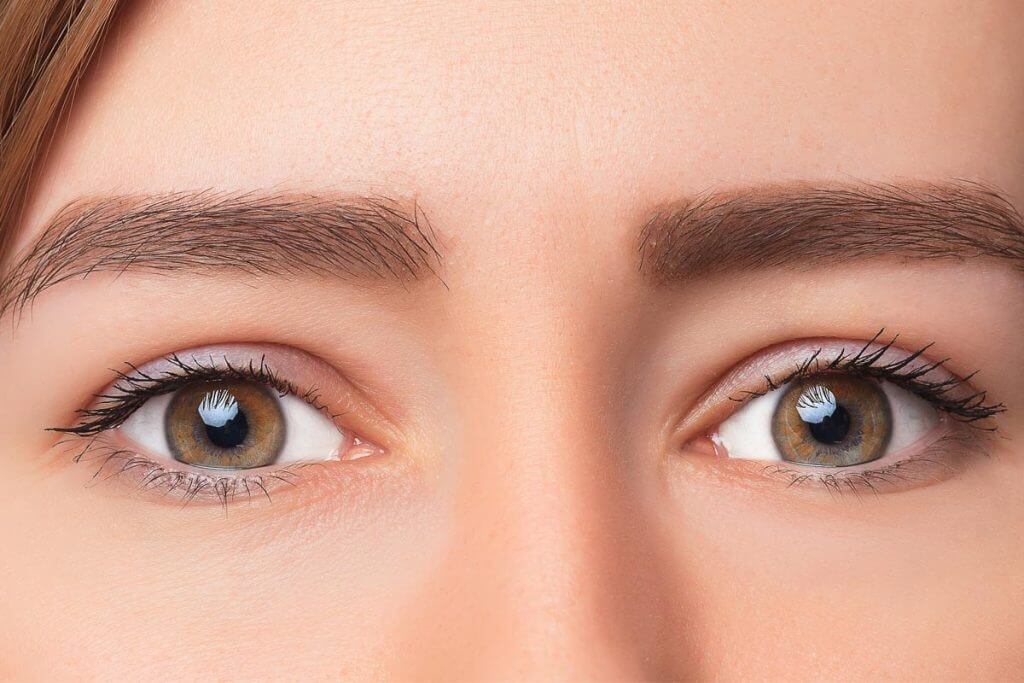
Establishing a diagnosis
The diagnosis for nystagmus must be made by an ophthalmologist who will subject you to various examinations and test your eyesight. In addition, they will look for other eye problems that may be associated with nystagmus. As we have already mentioned, the problems that can be the cause are strabismus, cataracts, and problems with the retina or optic nerve.
One way to experience nystagmus is to spin around on your axis for 30 seconds, stop suddenly, and try to focus on one object. If a person has nystagmus, after this test the eyes will first move slowly in one direction only, and then they will move rapidly in the opposite direction.
Other tests that can be used to diagnose nystagmus include:
- Eye movement recording
- Ear examination
- Neurological examination
- MRI of the brain
- CT diagnostics of the brain mozga
Treatment of nystagmus
If nystagmus occurs later in life, there may be quite simple solutions to alleviate the condition. Sometimes it is enough to stop taking certain medications, stop drinking alcohol or use drugs. That is why it is very important to determine the true cause of nystagmus.
On the other hand, wearing the right lenses or glasses to improve your vision won’t cure nystagmus, but it can help control other problems that could also affect nystagmus. Surgery on the eye muscles may also be an option, and its main goal is to help with the head tilt that often comes with nystagmus. The same operation can also improve vision.
In adults, there are drugs that can alleviate the symptoms, but this is not the case when it comes to children. These include anti-seizure medications as well as muscle relaxants. For people with nystagmus who have diopters at a distance, laser diopter correction is also recommended.
Exercises for nystagmus
There are a number of exercises that can be beneficial when it comes to treating nystagmus, and these may include:
Channel repositioning consists of a series of guided head and body movements. These exercises help by relieving dizziness caused by nystagmus.
In addition, there are balance exercises that your doctor should show you and that you should do at home every day to improve your balance.
And finally, there are motion stabilization exercises that should help keep the eyes focused on the object while the head is moving. This can also help alleviate feelings of insecurity or imbalance.
Gait and balance training involves standing and walking on different surfaces, and is very important for better balance maintenance, which could have a preventive effect on falls.
Habituation exercises
The doctor should show you exercises that are adapted to your condition, and among them may be exercised to get used to, which, at first, could make you dizzy. It is very important that you continue, as the symptoms should only last for a minute. If you continue with the exercises, they should relieve the dizziness, and if you persist in some sudden movements that caused dizziness before, it will no longer do so.
Tips for living with nystagmus
If your child has nystagmus, encourage him and encourage him to use his vision as often as possible. Let him play with large, brightly colored toys that are easy to use. Choose toys that make noise and are made of unique textures.
Allow the child to hold the books close to his eyes with his head tilted to one side. Also, let them wear hats or caps even indoors to reduce their glare as much as possible. Talk to your child’s teachers and educators in order to make the child’s stay at school or kindergarten as easy as possible, let the child choose where to sit so that he can see the teacher and the blackboard.
For adults…
When it comes to adults who suffer from nystagmus, there are some choices and habits they can adopt in order to better cope with the problems this condition brings. Here’s a list of things you can change today.
Adjust the brightness, color, and font size of your computer monitor to make your work as easy as possible.
If you need it, use additional lighting such as a desk lamp to make your work even easier.
Wear tinted glasses indoors to minimize glare.
Explain your condition to close friends and family to help them understand what you are really dealing with. The same is true if you have a child who has nystagmus.
Go for regular check-ups with an ophthalmologist, regularly check your diopter, and change lenses and glasses as needed.
When reading for a long period, rest your eyes often and use a ruler to help you follow the lines.
We hope that by reading this text, you were able to get answers to all potential questions and doubts you had regarding the health problem of nystagmus. Below we recommend that you also read: Strabismus or Farsightedness – What is it, what are the causes, and how is it treated?
Take our quick test to find out if laser eye surgery is your path to glasses-free vision
Not all laser eye surgery options are the same. Find out which one is right for you by taking our quick 2-minute self-test
Our most popular procedures
What our patients say...

★ ★ ★ ★ ★
“All praise, expertise and kindness of the entire staff headed by Kozomara
"

★ ★ ★ ★ ★
“I turn to Kozomar ophthalmology with great pleasure, even though I came from Slovenia for their services. I am extremely grateful for their professional treatment during diopter removal and blepharoplasty. Every time I am impressed by their dedicated and precise work. I would especially like to emphasize the respectable attitude of the entire staff”

★ ★ ★ ★ ★
“All the best! Very satisfied with everything, from the appointment, examination, operation and control. Thank you to the doctor and the whole team for their expertise and kindness!!!”

★ ★ ★ ★ ★
“It is with great pleasure that I thank the entire staff and dr. Kosamora. I am very satisfied with the service, I came yesterday with very poor eyesight. They restored my vision to 100% painlessly, quickly and professionally. I recommend this clinic to everyone and THANK YOU very much. Sincerely, Adnan Jusić.”

★ ★ ★ ★ ★
“Congratulations, I've done several procedures so far, from aesthetics to vision correction. I'm over the moon! Kudos!”

★ ★ ★ ★ ★
“Very friendly staff, medical specialists and technology of the highest quality”
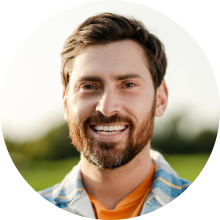
★ ★ ★ ★ ★“I found out about the clinic from a friend. The professionalism during the examination and the kindness of the entire staff, after two or three days they create an almost friendly relationship with the patients.”

★ ★ ★ ★ ★“Laser dioptre removal done in 3/23. Service at the level, wonderful and very kind staff. Everything was as it was said at the examinations. Clear vision from the first day, thank you from the bottom of my heart! ????”
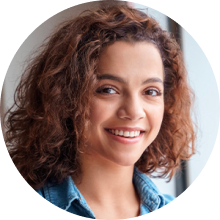
★ ★ ★ ★ ★
“Excellent team, kindness and professionalism! All recommendations!”

★ ★ ★ ★ ★
“Very friendly and competent team!
Dr. Kozomara, himself is a top professional! I felt very well looked after. Was fully explained. I've been watching in HD quality for a few days now
Thank you very much!!!”
We have replaced the images of the actual patients who provided these testimonials to protect their privacy

